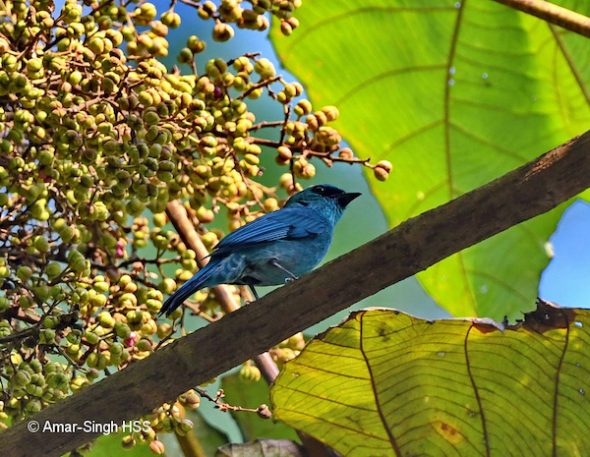Three new species of birds were seen feeding on the fruit of the Giant Mahang (Macaranga gigantea) on this day. Verditer Flycatchers (Eumyias thalassinus thalassoides), Green-backed Flycatchers (Narcissus Flycatcher, Ficedula narcissina elisae) and Oriental Magpie Robins (Copsychus saularis musicus).

Verditer Flycatcher.
Birds that I have personally observed feeding on the Giant Mahang fruit include:
- Emerald Dove (Chalcophaps indica)
- Blue-crowned Hanging Parrot (Loriculus galgulus)
- Crimson-winged Woodpecker (Picus puniceus observandus)
- Banded Woodpecker (Picus miniaceus malaccense)
- Brown Barbet (Calorhamphus fuliginosus hayii)
- Red-throated Barbet (Megalaima mystacophanos mystacophanos)
- Gold-whiskered Barbet (Megalaima chrysopogon laeta)
- Asian Koel (Eudynamys scolopaceus malayanus)
- Buff-vented Bulbul (Iole charlottae)
- Cream-vented Bulbul (Pycnonotus simplex simplex)
- Olive-winged Bulbul (Pycnonotus plumosus plumosus)
- Red-eyed Bulbul (Pycnonotus brunneus)
- Spectacled Bulbul (Pycnonotus erythropthalmus)
- Yellow-vented Bulbul (Pycnonotus goiavier gourdini)
- Asian Fairy Bluebird (Irena puella malayensis)
- Greater Green Leafbird (Chloropsis sonnerati zosterops)
- Blue-winged Leafbird (Chloropsis cochinchinensis moluccensis)
- Green Iora (Aegithina viridissima)
- Ashy Minivet (Pericrocotus divaricatus divaricatus)
- Oriental Magpie Robin (Copsychus saularis musicus)
- Orange-headed Thrush (Zoothera citrina)
- Asian Glossy Starling (Aplonis panayensis strigata)
- Lesser Cuckooshrike (Lalage fimbriata)
- Mugimaki Flycatcher (Ficedula mugimaki)
- Yellow-rumped Flycatcher (Ficedula zanthopygia)
- Asian Brown Flycatcher (Muscicapa dauurica)
- Green-backed Flycatcher (Narcissus Flycatcher, Ficedula narcissina elisae)
- Verditer Flycatcher (Eumyias thalassinus thalassoides)
- Everett’s White-eye (Zosterops everetti)
- Grey-breasted Spiderhunter (Arachnothera modesta)
- Spectacled Spiderhunter (Arachnothera flavigaster)
- Spectacled Bulbul (Pycnonotus erythropthalmus)
- Scaly-Breasted Bulbul (Pycnonotus squamatus)
- Purple-naped Sunbird (Hypogramma hypogrammicum)
- Ruby-cheeked Sunbird (Anthreptes singalensis interposita)
- Plain Sunbird (Anthreptes simplex)
- Orange-bellied Flowerpecker (Dicaeum trigonostigma)
- Crimson-breasted Flowerpecker (Prionochilus percussus)
- Other unidentified Sunbirds & Flowerpeckers
Amar-Singh HSS (Dato’ Dr) – Ipoh, Perak, Malaysia
Location: Kledang-Sayong Forest Reserve, Ipoh, Perak, Malaysia
Habitat: Trail along primary jungle
Date: 17th January 2020
Equipment: Equipment: Nikon D500 SLR with Nikon AF-S Nikkor 500mm f/5.6E PF ED VR, handheld with Rode VideoMic Pro Plus Shotgun Microphone








